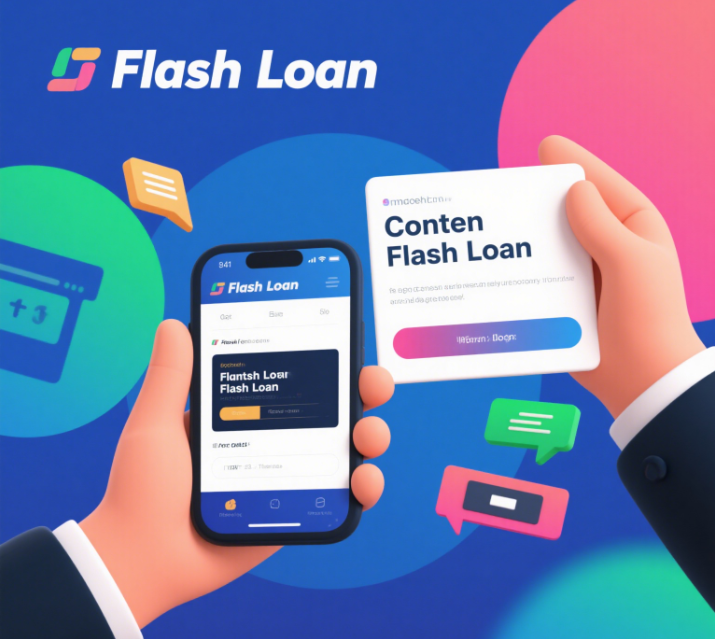In the decentralized finance (DeFi) landscape, flash loans have emerged as a groundbreaking innovation, enabling users to borrow large sums of cryptocurrency without collateral—as long as the loan is repaid within the same blockchain transaction. This revolutionary concept, pioneered by protocols like Aave and dYdX, has reshaped financial strategies, from arbitrage opportunities to protocol governance manipulation. Below, we delve into the mechanics, use cases, risks, and future of flash loans, exploring why they’re a cornerstone of DeFi’s evolution.
Understanding Flash Loans: How Do They Work?
Flash loans operate on a simple yet transformative principle: borrow, execute, repay—all within a single blockchain transaction block. If the repayment fails, the entire transaction is rolled back, ensuring no funds are lost. This mechanism relies on smart contracts to enforce atomic execution, making it a game-changer for DeFi.
Here’s a breakdown of the process:
- Borrow: Users request a loan from a DeFi protocol (e.g., Aave, Uniswap) without collateral.
- Execute: The funds are used for actions like arbitrage, liquidity provision, or governance voting.
- Repay: The borrowed amount plus a small fee (typically 0.09% on Aave) must be returned before the block finalizes.
- Rollback: If repayment fails, the transaction is reverted, protecting lenders’ funds.
This frictionless process eliminates the need for upfront capital, democratizing access to high-value financial operations.
Key Use Cases of Flash Loans
Flash loans have unlocked a multitude of applications, driving innovation in DeFi:
1. Arbitrage Opportunities
Arbitrageurs exploit price discrepancies across decentralized exchanges (DEXs) by borrowing funds to buy low on one platform and sell high on another—all within seconds. For example, if Bitcoin trades at $40,000 on Uniswap and $40,200 on SushiSwap, a flash loan allows traders to profit from the 价差 without holding capital.
2. Liquidity Provision
Traders use flash loans to temporarily inject liquidity into pools, earning fees or manipulating prices. For instance, a user might borrow $1 million in USDC to add liquidity to a pool, then withdraw it after collecting fees.
3. Debt Refinancing
Users can refinance existing loans at better rates. Suppose a trader has a loan with high interest; they can borrow a flash loan to repay it and secure a new, cheaper loan—without liquidating assets.
4. Governance Attacks
While controversial, flash loans have been used to manipulate DeFi governance. Attackers borrow governance tokens to vote on proposals (e.g., changing protocol parameters) and repay the loan afterward, leaving lasting impacts on the ecosystem.

Risks and Challenges of Flash Loans
Despite their benefits, flash loans pose significant risks:
1. Smart Contract Vulnerabilities
Bugs in smart contracts can lead to exploits. For example, the 2025 attack on Polter Finance saw attackers borrow governance tokens to manipulate prices, causing $12 million in losses . Audits and security protocols are critical to mitigate this risk.
2. MEV (Maximal Extractable Value)
Front-running bots often target flash loan transactions to steal profits. Protocols like Flashbots aim to reduce MEV, but it remains a persistent issue.
3. Market Volatility
Price slippage during a transaction can wipe out profits. For example, if a flash loan arbitrage relies on a $200 price difference, a sudden market dip could turn the trade into a loss.
4. Regulatory Scrutiny
Flash loans’ potential for misuse has drawn attention from regulators. The EU’s MiCA framework and U.S. SEC are exploring rules to govern DeFi protocols, including flash loan usage .
The Future of Flash Loans: Innovation and Integration
As DeFi matures, flash loans are evolving alongside it:
1. Institutional Adoption
Institutions are increasingly leveraging flash loans for sophisticated strategies. For instance, hedge funds use them to hedge positions or optimize portfolio balances across markets.
2. Cross-Chain Flash Loans
Projects like Multichain and Thorchain are enabling flash loans across blockchains, expanding arbitrage opportunities and liquidity pools.
3. AI-Driven Automation
AI-powered bots are emerging to identify and execute flash loan opportunities autonomously, reducing human error and increasing efficiency.
4. Regulatory Compliance
DeFi protocols are adopting KYC/AML measures to comply with regulations. Aave Arc, for example, offers permissioned flash loans for institutional users .
Conclusion: Flash Loans as a Catalyst for DeFi Growth
Flash loans have redefined what’s possible in decentralized finance, offering unprecedented flexibility and accessibility. While risks like smart contract vulnerabilities and regulatory hurdles persist, their role in driving innovation and liquidity cannot be overstated.
For real-time insights into flash loans, DeFi trends, and market analysis, Bitora provides comprehensive coverage and tools to navigate this dynamic landscape. Stay ahead with Bitora’s expert analysis and secure your position in the future of finance.
Stay informed. Stay ahead. Explore Bitora’s DeFi resources today.









Leave A Reply